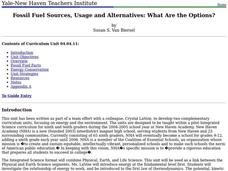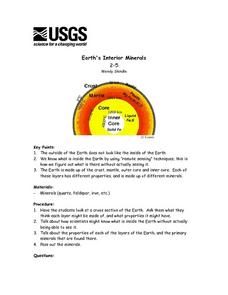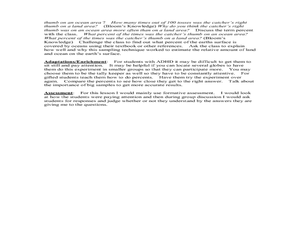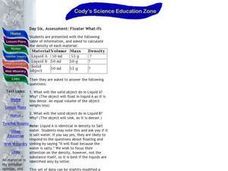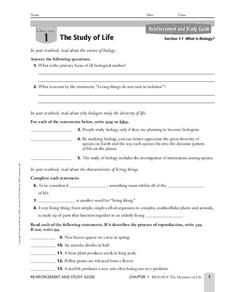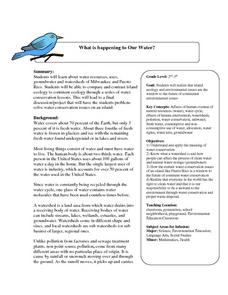Curated OER
Microbial Influence on Earth's Systems
Learners identify the different biogeochemical cycles on Earth. In this biology lesson, students observe microbes under a microscope. They compare and contrast respiration and photosynthesis.
Curated OER
Digging the Earth's Crust
Students investigate the Earth's crust. In this geology lesson, students identify the materials made up of the Earth's crust and investigate the different kinds of soil.
Curated OER
Planet Earth in Cross Section
Students will examine the layers of the Earth. In this geology activity, students create a scale model of the Earth's interior using cash register tape. They will determine the percentage of error in the scale compared to the actual size...
Curated OER
Earth's Layers Foldable Questions Sheet
In this earth's layers learning exercise, students answer questions about the main layers of the earth using the model they built in the activity. They write details about each layer and answer questions.
Curated OER
Fossil Fuel Sources, Usage and Alternatives: What are the Options?
Students identify the different sources of fossil fuels. In this environmental science lesson, students research about how these impact our environment. They explore renewable energy sources that could replace fossil fuels.
Curated OER
Science Lessons for Grade 7
Seventh graders construct a food chain based on pictures shown on the board. In this biology lesson, 7th graders describe the motion of particles as energy is changed. They explain how pH changes during neutralization.
Curated OER
Earth Day
Young scholars practice addition and estimation. They use tens models to solve the problems related to grocery bags and Earth Day. Afterwards, they complete an activity sheet and draw a large grocery bag decorated with Earth Day messages.
Curated OER
Pollution is Not a Solution
Students explore the environment by completing science worksheets in class. For this water conservation lesson, students identify ways water is used in our society and how we abuse the privilege. Students discuss methods to reduce water...
Curated OER
What is Momentum?
In this momentum learning exercise, students will calculate the maximum forward momentum of the Apollo 11 lunar spacecraft at three different stages of its space travel.
Curated OER
Earth's Interior Minerals
Students identify the layers of the Earth. They discover the properties and minerals in each layer. They answer questions about the minerals found to end the lesson.
Curated OER
When Everything Old is New Again
Students imagine what it would be like if today's animals became dinosaurs, or the ancient creatures reappeared to roam the earth. They invent a dinosaur of the future. What might a futuristic triceratops look like? Students are taught...
Curated OER
What Part of the Earth's Surface is Covered by Oceans?
Third graders investigate oceans. In this Earth science lesson, 3rd graders predict how much of the Earth's surface is covered by oceans. Students determine if their predictions are accurate by throwing a globe to...
Curated OER
Introduction to Earth's Dynamically Changing Climate
Students identify the most common causes of global warming. For this earth science lesson, students use an interactive website to explore changes over time in sea ice, sea level, carbon emissions, and average global temperature. They...
Curated OER
Earth: The Apple of our Eye
Pupils are led through a demonstration in which they cut open an apple, which represents the earth. They follow through the hands-on lesson, cutting the apple into various portions--each representing some aspect of the earth.
Curated OER
Science - 'Why does the wind blow?'
For this earth science worksheet, students read a poem about the wind and learn why the wind blows. After reading the poem and informative paragraphs that follow it, students answer 2 questions regarding the information they read....
Curated OER
Sun-Earth Day Flip Books
Learners assemble flip books. In this Earth science lesson, students read about different solar occurrences and create flip books. This teacher resource has links to create six different flip books.
Curated OER
Day Six: Floater What Ifs
Learners observe earth science by examining results from an experiment. In this buoyancy lesson, students practice floating different items in two different liquids and identify why certain objects will float and others sink. Learners...
Curated OER
What is Biology?
In this science of biology instructional activity, students will review the concepts relating to biology including the characteristics of living things, the process of reproduction, adaptations, and evolution. This instructional activity...
Curated OER
What is Climate?
In this weather worksheet, students read a brief excerpt that compares the various types of climates found on Earth. Then they explain where the low- and high-pressure systems follow each other throughout the year.
Curated OER
What is Magnetism?
In this magnetism worksheet, learners review what magnetism is by matching 5 words to their definitions. Then students use a diagram showing the pattern of iron fillings around magnets to complete 4 short answer questions.
Curated OER
What is the Solar System?
Students study the solar system. For this solar system lesson, students create graphic organizers, and participate in class demonstrations illustrating size and distance within the solar system.
Curated OER
What is Happening to Our Water?
Learners compare and contrast Wisconsin's water resources to that of Puerto Rico. They research books about islands, particularly the Puerto Rican islands. Student view illustrations of island ecology. They discuss the illustrations and...
American Museum of Natural History
Ask a Scientist About Our Environment
Scientists respond to 26 question posed by learners. These experts answer in easy to understand language, include photos to illustrate the issue, offer suggestions for how young people can make a difference, and supply links to resources...
Curated OER
Rocks and Minerals
Review the difference between rocks and minerals using this resource. Learners identify and investigate the physical properties of these objects. They create a Venn diagram to compare and contrast types of rocks. This is a motivating way...




